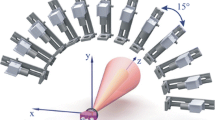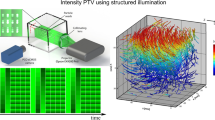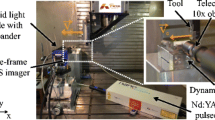Abstract
An automated 3D tracking technique for studying the motion of particles deep within the tumbling ball charge of an experimental grinding mill is described. The use of a Biplanar angioscope for the accurate location of objects moving in three dimensions is a novel application of this X-ray equipment. The X-ray beam used to produce the image data was parameterized using an accurately measured control frame. Preliminary experiments were conducted on a Perspex mill with a length and diameter of 140 mm. The digitally acquired X-ray images of the tumbling mill were processed using a fully automated imaging technique. The final 3D coordinates of the tracked particle trajectories are accurate to within 0.40 mm. This indicates that the technique is robust and thus capable of providing accurate verification data for the numerical modeling of the tumbling motion in mills.
Similar content being viewed by others
References
Powell, M.S., andNurick, G.N., “A Study of Charge Motion in Rotary Mills: Parts 1–3, Minerals Eng.,9 (2),259–268 (1996);9 (3), 343–350 (1996);9 (4) 399–418 (1996).
Mishra, B.K. andRajamani, R.K., “Simulation of Charge Motion in Ball Mills: Experimental Verification and Numerical Simulation,”Int. J. Min. Proc.,40,171–197 (1994).
Sears, F.W., Zemansky, M.W., and Young, H.D., University Physics, 5th edition, Addison-Wesley Publishing Company (1980).
Klein, F., Elementary Mathematics from an Advanced Standpoint. Geometry.Translated from the German 1939.Dover Pulications Inc., USA (1908).
McNeil, G.T., “X-ray Stereo Photogrammetry,”Photogram. Eng.,32 (6),993–1004 (1966).
Canny, J.A., “Computational Approach to Edge Detection,”IEEE Transactions on Pattern Analysis and Machine Intelligence, PAMI-8 (6),679–698 (1986).
Gonzalez, R.C. and Wintz, P., Digital Image Processing. Addison-Wesley Publishing Company (1977).
Govender, I., Powell, M.S., andNurick, G.N., “3D Particle Tracking: A Rigorous Technique for Verifying DEM Predictions,”Minerals Engineering,14 (10),1329–1340 (2001).
Karara, H.M. (ed.), Non-topograhic Photogrammetry, 2nd edition, American Society for Photogrammetry and Remote Sensing (1989).
Adams, L.P., “X-ray Stereophotograpmmetry Locating the Precise, Three-dimensional Position of Image Points,”Medical and Biological Engineering and Computing,19,569–578 (1981).
Karara, H.M. and Abdel-Aziz, Y.I., “Direct Linear Transformation from Comparator Coordinates into Object Space Coordinates in Closerange Photogrammetry,” ASP Symposium on Close-range Photogrammetry (1971).
Karara, H.M. andAbdel-Aziz, Y.I., “Accuracy Aspects of Non-metric Imageries,”Photogram. Eng.,40 (11),1107–1117 (1973).
Tabatai, A.J. andMitchell, O.R., “Edge Location to Subpixel Values in Digital Imagery,”IEEE Transactions on Pattern Analysis and Machine Intelligence, PAMI-6 (2),188–201 (1984).
Author information
Authors and Affiliations
Rights and permissions
About this article
Cite this article
Govender, I., Powell, M.S. & Nurick, G.N. Automated imaging to track the 3D motion of particles. Experimental Mechanics 42, 153–160 (2002). https://doi.org/10.1007/BF02410877
Received:
Revised:
Issue Date:
DOI: https://doi.org/10.1007/BF02410877




